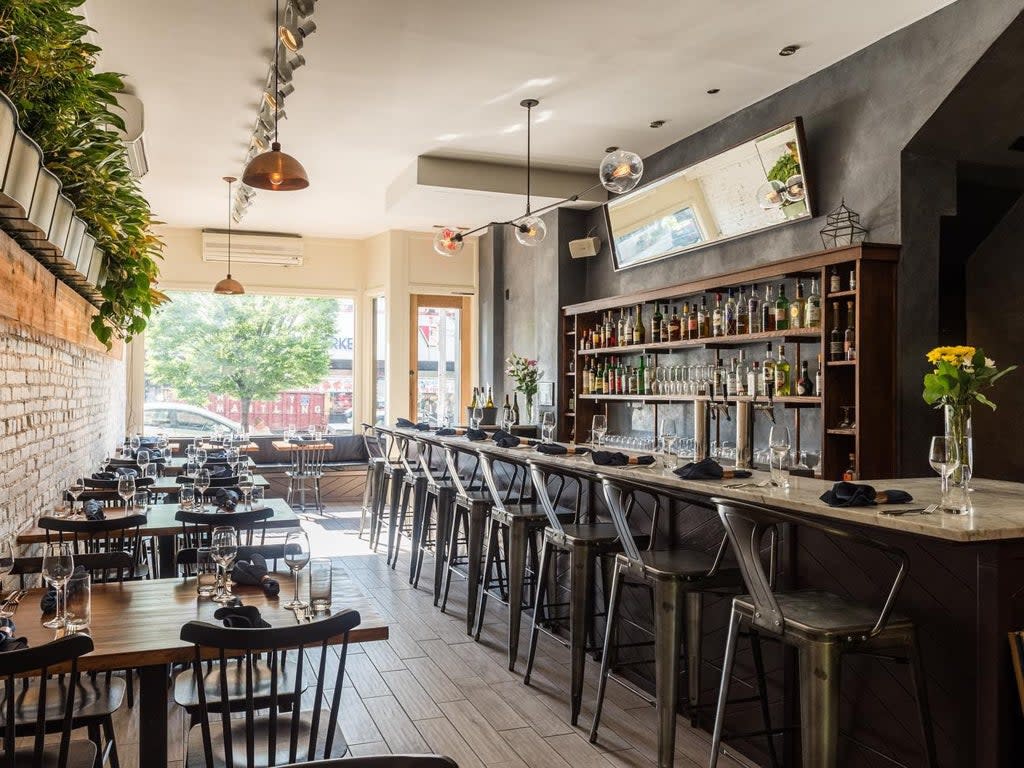Olmsted: An exercise in Scandinavian-American fusion

Immediately beside Prospect Park – Brooklyn’s answer to Manhattan’s Central Park, designed with many identical features by the architects Frederick Law Olmsted and Calvert Vaux – is an area in New York City known for strollers, parents clutching expensive coffees, and sympathetically restored brownstone row houses. This is Park Slope, the poshest part of Brooklyn bar the celebrity-infested waterfront neighbourhood Brooklyn Heights, and it shows. Park Slope bursts with activity, with toddlers and tea parties and poodles on leashes; proposals happen inside the park and dog trainers gather to train expensive pedigrees on Sundays; brunches are had along pedestrianised streets.
Yet despite its reputation for upscale living and its abundant restaurants and bars, Park Slope has a reputation for culinary disappointment. You can get a good slice of pizza anywhere along Fifth Avenue; there are a couple of impressive trattorias, such as the perpetually booked-up Al Di La; everything from all-day breakfast to bubble tea to upscale, even experimental, American dining can be had – and yet, while everything is good, it is rarely great. For greatness, you have to venture into one of the surrounding areas.
Just a few streets away, the slightly scrappier neighbourhood of Prospect Heights begins. Here, rents are a little more affordable and the clientele is either a little younger or a little more down-at-heel. There are still pedestrianised streets, but you’re more likely to find buskers than buggies on them, and the drinking-holes are a little less sports bar and a little more tongue-in-cheek (Branded Saloon, a dive bar done out entirely in wood in impressive commitment to its name, is a stand-out example.) Along this street, where expensive wine shops rub shoulders with cheap joints selling beers in plastic cups alongside deep-fried Oreos on paper plates, you can find one of the most interesting restaurants in Brooklyn: Olmsted, so understatedly named after that Prospect Park architect.
Olmsted feels like an exercise in Scandinavian-American fusion, though it doesn’t advertise itself that way. With its “living wall” of herbs inside the establishment, its clean lines and white walls, and its well-tended garden out the back (some of which supplies the produce for the dishes served nightly), it feels more than a little northern European. Little surprise, then, that chef and owner Greg Baxtrom most recently worked at Lysverket in Norway, a Michelin guide restaurant with somewhat similar decor that concentrated on “modern Norwegian cuisine”.
The fare is always seasonal, but not restrictive. And it helps that the service is also attentive without being in-your-face, friendly without feeling fake
But Olmsted borrows from across the world rather than drawing its inspiration from a single country. On the menu are dishes like “agedashi scallop”, a play on the Japanese fine dining staple agedashi tofu; “Brussels sprout falafel”; “duck ham air baguette”; and “porcini red fife brioche with aerated Thai long peppercorn scented ricotta”. Some offerings are so playful they border on the ridiculous, others – like “popcorn monkfish” – seem like a deliberate middle finger to the establishment. All of them are, however, unfailingly delicious. It’s clear that experiments are done in Olmsted’s kitchen, and only the successful ones make it through: Brooklynites talked for months about their homemade lobster crackers in 2021, as well as their “make-your-own Smores” dessert option, which included a waiter bringing a contained fire to your outdoor table and supplying homemade cookies and homemade marshmallows to toast over it on skewers (complete with Hershey’s chocolate squares.)
Olmsted’s chief sommelier, Zwann Grays, has come up with a pleasantly unexpected wine list, with rosé from Georgia (the country, not the state!) and red wine from Lefkada in Greece. Indeed, all the wines are European; there’s not a Californian white in sight. What that says about sustainability in a New York-based restaurant is perhaps worth talking about, although arguably the journey from France to this far along the east coast is just as arduous as the one from out west.
The secret to Olmsted’s success is its atmosphere of fine dining without pretension, and experimentalism without foolishness. The food presentation always makes sense (no deconstructed burgers here) but remains unexpected. The fare is always seasonal, but not restrictive. And it helps that the service is also attentive without being in-your-face, friendly without feeling fake. There’s no doubt about it – this place is Brooklyn-famous already; but it has the air of somewhere that might, just might, also become world-famous in its time.

 Yahoo Movies
Yahoo Movies 
